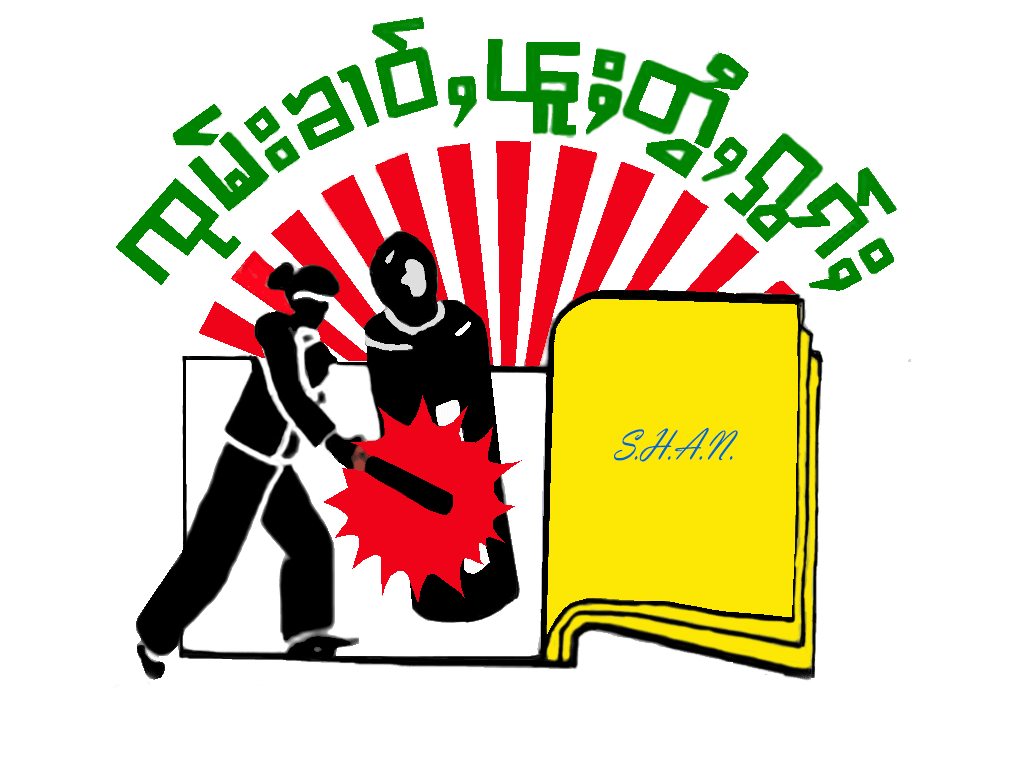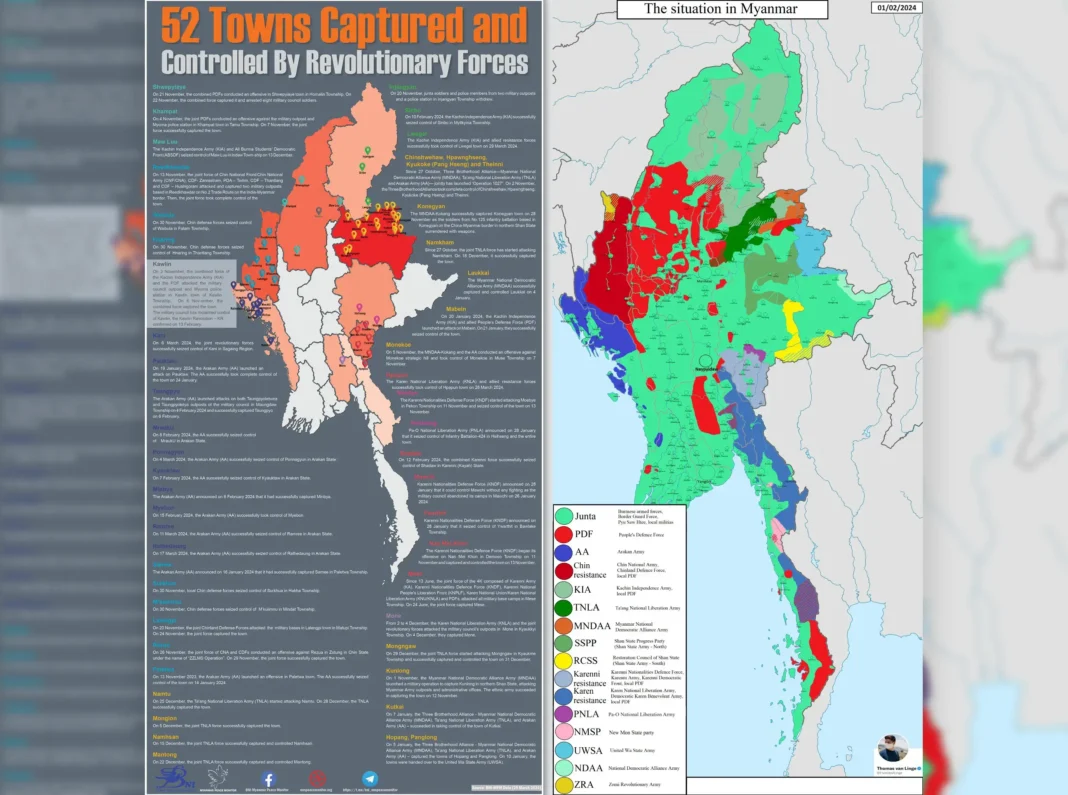Community Analysis Support System (CASS) published a report aiming to support humanitarian intervention purposes in Shan State in April. As “the provided information, assessment, and analysis are designated for humanitarian purposes only and as such should not be cited,” there will be no word for word for word citation of the report but merely borrow the speculation of three scenarios advanced by the CASS.
The said three scenarios are whether the Haigeng Agreement holds in 2024; Myanmar military junta or State Administration Council (SAC) tries to recapture lost territory; and the Three Brotherhood Alliance (3BHA) launches pre-moonsoon offensives.
In addition, the two sub-scenarios included are, possibility of tension-conflict increase between the ethnic armed organizations (EAOs) in northern Shan State; and violence heightened in southern Shan State.
But before we delve further into the the three scenarios, we may like to look at the contemporary political and military situation of the country briefly.
Brief recent backdrop
According to the report of Burma coup resistance notes of April 6, 2024 and various news outlets, more than 40 towns across Myanmar or Burma are under the anti-junta ethnic-democratic loose alliance. Moreover, some 70 percent are not under the jurisdiction of the junta and only 30 percent of the country’s territories may be under its sway, if not completely in control. The recent National Unity Government (NUG) drone attacks on Naypyitaw is the case in point.
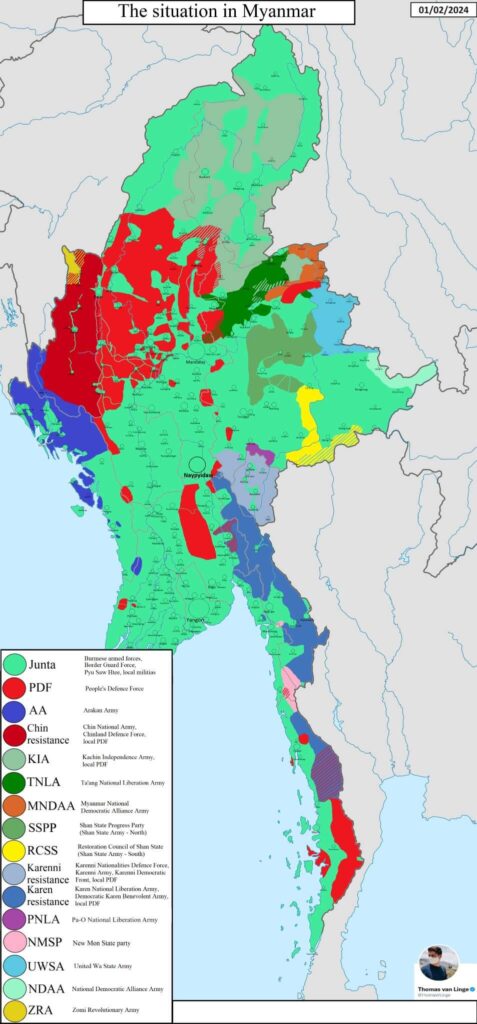
“The Kloud drone force and several others under the National Unity Government Ministry of Defense flew 29 fixed-wing drones into the Naypyitaw airport, dictator Min Aung Hlaing’s house, and the junta HQ in Zayathiri Township of Naypitaw Region on April 4, causing explosions. The drone teams report that 15 junta troops were killed and others wounded including 4 officers at the airport. The attack damaged the air strip, some aircraft, the map room and roof at the military HQ, and the dictator’s house. Video provided by the NUG shows a drone overflying the airport, meaning that Revolutionary technicians found a way to neutralize powerful drone jammers and air defenses used by the junta to shield the airport. The junta is reportedly in panic mode, seeking to bolster its air defenses,” writes the Burma coup resistance notes.
In Kachin, Arakan or Rakhine, Karen, Karenni, and Chin states, the junta is in the defensive and only could use airstrikes and long-range artillery bombardment to compensate for its lack of infantry troops on the ground to face the anti-junta alliance. In southern Shan State the junta was able to wrestle back Hsihseng town from the Pa-O National Liberation Army (PNLA), but the fight is far from over. Additionally, in Kawlin, Sagaing Region, the junta was able to recapture the town from the People’s Defense Force (PDF). But the general outlook is that the junta is in a jam when one look at the country’s situation as a whole.
Very recently, the junta troops have abandoned Myawaddy and surrendered en mass, some 600 troops, to the Karen National Liberation Army (KNLA), armed wing of the Karen National Union (KNU), and its allies attacking the town, which may be taken anytime soon. At this writing, after overrunning Thingannyinaung strategic base, KNU spokesperson Pado Saw Taw Nee said only Light Infantry Battalion 275 is left guarding the Myawaddy area.
He said this in a recent interview with Karen Information Center (KIC), Pado Saw Taw Nee said that there are reports that there is a commander of the 44th Division of the Military Council with the LIB 275. He said that it would be best if he gave up without fighting. It has already been two days, so KNU will have to take action, he said.
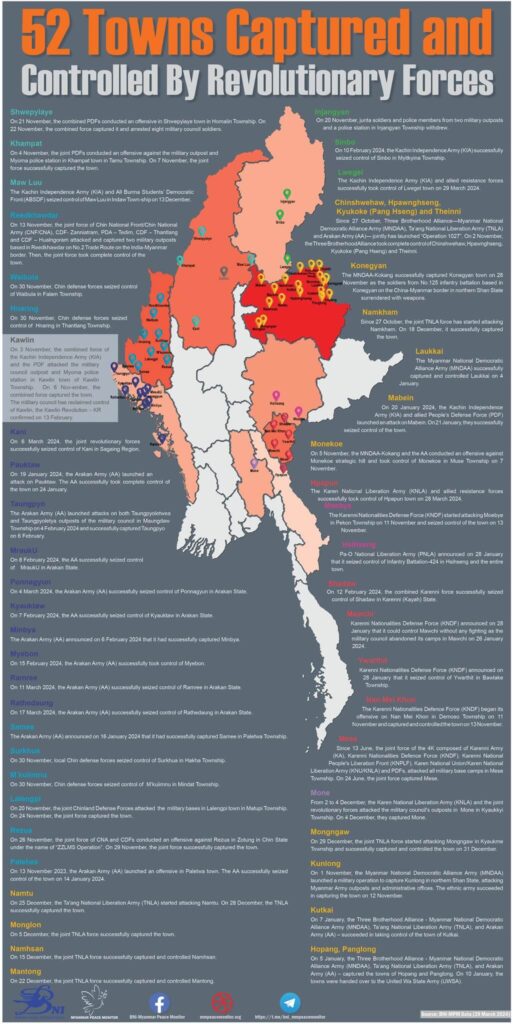
“A coalition of northern Sagaing People’s Defense Forces (PDFs) counter-attacked junta troops conducting terrorist raids on villages on the west side of Kawlin, the town that was liberated for 3 months and then re-occupied and destroyed by the junta. After burning villages, the troops camped in a monastery and a school, where the PDFs fired on them with mortars and small arms on March 31, killing at least 20.”
“Another coordinated PDF attack in Chaing Oo Township killed 17 junta troops and Pyu Saw Htee terrorists on March 31. On April 1-2 PDFs in Myaing Township of Magway Region invaded a junta base at Linkadaw and burned the bunkers there. The junta responded with jet and helicopter airstrikes. Then on April 5, PDFs in Pauk Township of Magway Region intercepted 200 junta troops as they emerged from a police barracks, using mines and gunfire to kill 22 of them.”
“A PDF fired five 107mm shock missiles at a junta weapons factory in Pauk Township on April 2, causing explosions and damage within the factory. The extent isn’t known,” according to the Burma coup resistance notes.
In southern Shan State, the same source reported, “After 32 days of continuous junta assault with jets, helicopters, mortar fire, and ground assaults, the junta finally retook much of Hsihseng town on April 3 from Pa-O ethnic forces who had liberated it. They did it by kidnapping civilians and using them as human shields. Due to the constant airstrikes, not much is left of the town besides rubble, and civilians are stepping on junta landmines. The Pa-O still have a presence, and combat is still intermittent.”
The feasibility of the three scenarios
Against this backdrop, now let us ponder on the three scenarios advanced by the CASS.
Concerning northern Shan State, the CASS first speculation Haigeng Agreement may hold on due to the military junta’s thinly spread out forces around the country, miserably depleting troop strength, and not to mention the low moral of its troopers, as can be seen by mass surrenders in Laukkai, Kokang, northern Shan State; hundreds of surrendering troops fighting against Arakan Army (AA) in Rakhine State in general; and just recently in Myawaddy Township where some 600 troops have surrendered.
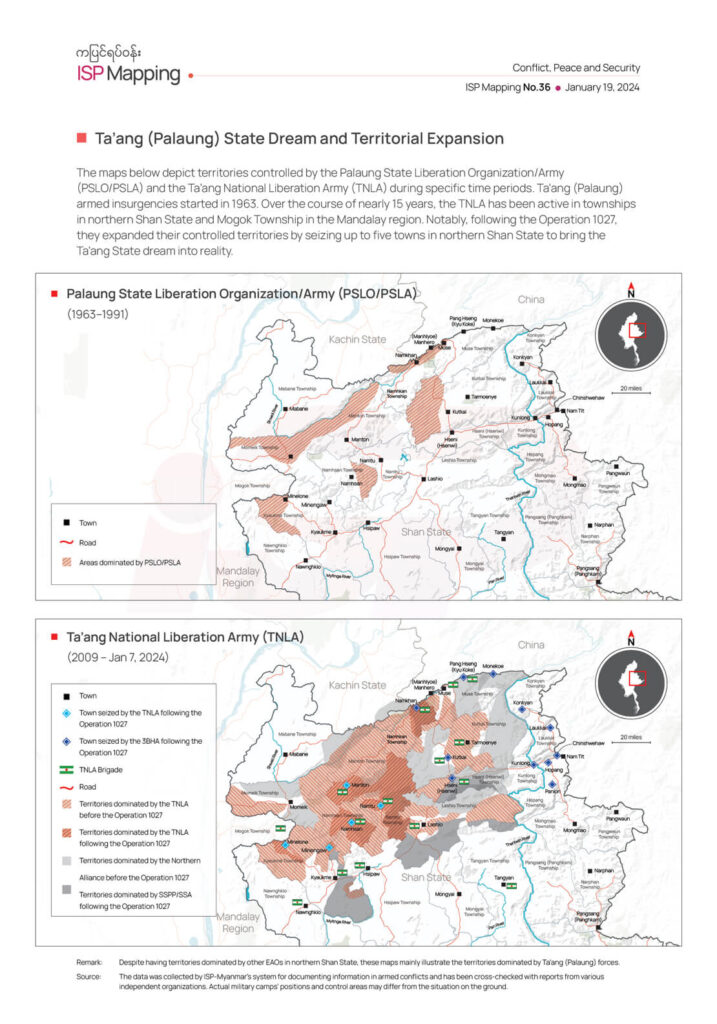
While there have been reports that the junta is beefing up its reinforcement in Lashio and also in Muse in northern Shan State from the air by helicopter transports, it is highly unlikely that it will start a massive offensive against the Ta’ang National Liberation Army (TNLA) and Myanmar National Democratic Alliance Army (MNDAA) or Kokang. And on top of that, the junta, the 3BHA, particularly the MNDAA and TNLA, and China seriously want to open the border-crossing trade routes through Muse and Chinshwehaw.
In the same vein, the second scenario of SAC trying to recapture lost territories in northern Shan State may not be in the offing, due to the reasons mentioned above in the first speculation scenario.
The third scenario of the 3BHA launching pre-moonsoon offensives in northern Shan State may also not happen, so long as the junta refrain from launching airstrikes, which is part of the Haigeng Agreement signed in China, Kunming on January 11, 2024.
The 3BHA may tolerate the on-and-off artillery bombardment from the junta and won’t choose to launch offensives as both the MNDAA and TNLA are busy trying to set up administrative infrastructure in their newly won territories.
Besides, the inter-EAO friction between the Shan State Progress Party (SSPP) and TNLA, including MNDAA with the former, and Kachin Independence Army (KIA) friction with both TNLA and MNDAA, are conflicts that could complicate the already convoluted situation in northern Shan State. The inter-ethnic conflict hasn’t burst out like the one between the SSPP and MNDAA, on 26 and 27 March, further may be due to the intervention or constraining act of the United Wa State Army (UWSA), which is the head of the seven-member Federal Political Negotiation and Consultative Committee (FPNCC), and all conflict parties are members of the setup. It goes without saying that China dictates the military situation in northern Shan State, as the Operation 1027 started with its green light, it also ended with China’s ceasefire demand intervention.
In a way, all conflict parties need a respite and serve all of them good. The junta is able to collect itself from the massive defeat, while the TNLA and MNDAA have achieved their desired area expansion to their liking, and solidifying their gains through building administrative infrastructure may well serve the purpose. It doesn’t matter now that they have promised to uproot the military dictatorship first for the good of the whole country.
In this connection, the two sub-scenarios of possible heightening of inter-EAO conflict in northern Shan State and increased violence in southern Shan State, are both possible. But latter scenario may be more likely to happen, given the present military top-dog situation for the junta in southern Shan State.
Where do the two Shan armies stand?
The two Shan armies positions have not changed drastically from the previous months.
The Restoration Council of Shan State (RCSS) is for negotiation and sticking to the Nationwide Ceasefire Agreement (NCA) of 2015. It headed a formation of new 7 EAO Alliance, a revamp of the Peace Process Steering Team (PPST), which is for all-inclusive peace process negotiation. Its leader Gen Yawd Serk toured Larng Khur Township in the first week of April, where he indulged in a sort of charm offensive, visiting monastery in Wan Hut village track and also inspecting new recruits in the training camps. In February, he also traveled to villages in Mongpan, Keng Tawng, Karli, and Kunhing townships.
SSPP on February 20 issued anti-junta statement vowing to welcome everyone that adhere to the anti-dictatorship, anti-racial supremacy and anti-narrow ethnonationalism, establishment of federal democratic union, with equality and rights of self-determination for all ethnic nationalities. There were news that SSPP was assisting the PNLA in its fight against the junta in Hsihseng area in February. But the SSPP hasn’t denied or confirmed the allegation when asked by a certain media.
On 26 and 27 March, SSPP fought the MNDAA as its was attacked with some 50 drones and deployment of some 200 attack troops against its position in Hsenwi Township. The clashes died down after that but no further development was ever mentioned publicly by both parties. Probably, both parties realized that it would be a lose-lose outcome, if it goes on.
In short, the two Shan armies are both inactive, especially where combating the junta is concerned.
Analysis
Difficult to say how the simmering inter-EAO conflict will pan out in northern Shan State, given tension between the MNDD and SSPP, including frictions between the TNLA and SSPP. Junta’s army is reinforcing its positions in Lashio, Kyaukme and Muse. SSPP is close to UWSA and has mutual security pact, if not openly made known. TNLA relied on UWSA for arms and also MNDAA. The same tense situation is true between the KIA and TNLA, and also MNDAA in Kutkai area with on-and-off frictions being reported during the past few months. However, the odd thing is all of these EAOs are under the FPNCC which is a political front headed by the UWSA and suppose to be united.
For now, the open inter-EAO conflict is under-wrap, except for the two-day clashes between the SSPP and MNDAA in Hsenwi Township, may be because of the UWSA big brother posture playing mediator role and also may be China doesn’t want to see war along the border, to keep the Haigeng Agreement in tact so that border trade can be reopened.
But in the long run, if TNLA and MNDAA tried to swallow the Shan majority areas and Kachin Kutkai area forcefully, the inter-EAO conflict could resume, as all parties are well armed and have local population backing them.
In sum, what the CASS called sub-scenario that is centered on inter-EAO conflict may simmer on, waiting to be erupted anytime soon. Another sub-scenario which is the war theater in southern Shan State mainly in Hsihseng Township may go on with the contestation, now that the junta has regain back Hsihseng town and the PNLA isn’t ready to accept defeat. Probably with the help of its allies from Karenni and local PDFs, PNLA may be determined to gain back the lost areas.
Given such development, the two sub-scenarios may be more pronounced than the three main scenarios within Shan State, which means the Haigeng Agreement will hold in northern Shan State, while the inter-EAO conflict will simmer on, with the possibility of increased hostility in southern Shan State war theater during 2024.
